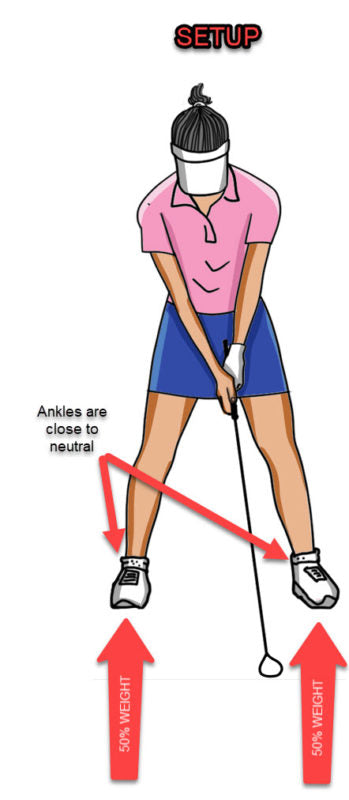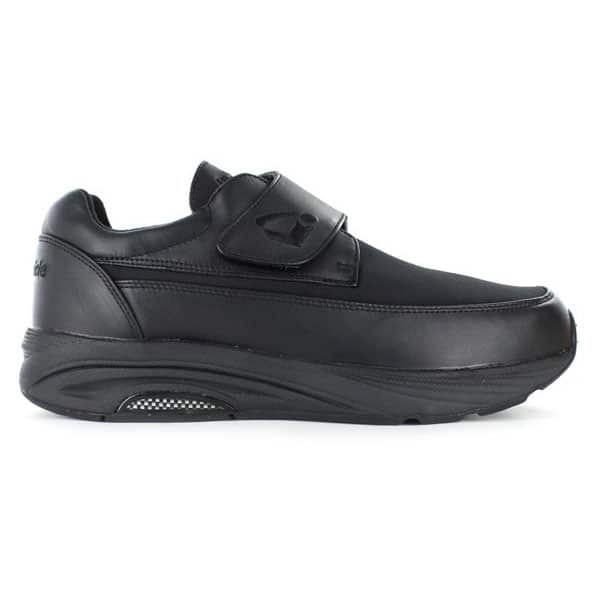What are the Best Insoles for Golf Shoes?
Golf is difficult enough to master without being distracted by pain caused by abnormal foot mechanics. When selecting the best golf insoles it is important to consider that the game of golf is more than just walking around the golf course.
Golf shoes need to support the foot during activity and they must also allow the foot to function freely when swinging the golf club. There is a bit of a paradox when it comes to selecting comfortable fit arch support insoles for golf shoes, on one hand when we are walking we need the insoles to have arch support, heel support, and rear foot support to prevent foot issues, and on the other hand, when swinging the club we need the feet to be able to move freely enough to perform the golf swing technically correct.
What causes foot pain when golfing?
When the feet pronate, they roll toward the midline of the body. This rolling in causes the joints of the feet to unlock and they become an inefficient lever to propel the foot when walking. It is important to control over-pronation to help to limit foot and lower limb pains from overuse injuries.
When the feet are allowed to over-pronate the muscles, tendons and ligaments become overworked as they are forced to actively support the feet. Over time this active control of the foot leads to muscle fatigue, aching legs, and overuse injuries.
Even the most experienced golfers will know that when playing golf for long periods, the proper fit and support of their golf shoes is essential to a comfortable day on the course.

What injuries are common in golf?
Of the lower limb injuries, the most common injuries reported by golfers are plantar fasciitis, neuromas, patellofemoral syndrome (knee pain), bunion pain (1st Mtpj pain), Achilles tendinitis, and trochanteric bursitis (lateral hip pain).
These types of injuries are similar to what we would see in a walking group. This is of course not surprising as a large part of the golf game is walking. During an average game of 18 holes, golfers can walk around 8km. That is if they can hit the ball straight.
Golf – A game of 2 Aspects – Insoles for golf shoes must support both
As a podiatrist when we are looking at golf injuries and foot comfort while getting around the golf course we need to consider 2 aspects. 1 – Walking the course and 2 – The Swing. Each aspect of the golf game has different requirements for feet and what the orthotic insoles should do to keep the feet functioning correctly and also pain-free.
1 – Walking the course – Support needed as per walking and running
When we are chasing that little white ball around the golf course the support that we get from most shoes is not enough. A soft arch support insole will add stability to the foot and limit foot pain such as plantar fasciitis.
In this phase of the game of golf, we need the orthotic insole to support the foot as if we were walking or running. We need to have a high arch support full-length insole for comfort and to maintain optimal foot mechanics.
Most golf shoes do not have enough arch support built into the shoes as standard so an off-the-shelf or custom-made orthotic will need to be added for the best fit and comfort.
2 – Golf Swing – Freedom for the foot to supinate and pronate needed
During the swing phase, the orthotic needs to allow enough motion at the foot and ankle so as not to inhibit the swing. Here we will be looking at the feet in the swing phase. From a lower limb and ankle point of view, there are 5 key phases of the golf swing.
To better understand this we will go over a very basic outline of what the feet are doing in each of the 5 phases of the golf swing.
Phase 1: Setup

During the setup, the golfer is balanced with weight approximately even on both feet. Both feet are in a neutral position (not supinated or pronated). The ball will be positioned forward. Both feet should be allowed to rest in a neutral position by the shoes and insoles (not rolled in or rolled out). Stability is the aim of the setup phase at the feet.
Phase 2: Takeaway

During the take-away phase, the weight is shifted towards the back foot, the lateral border of the back foot is loaded, and the back foot supinates (rolls out). The insoles and shoe should allow the feet to roll under control at this phase.
Phase 3: Downswing

Weight shifts to the front foot with the forward motion of the club. The back foot pronates and valgus stress is placed on the back knee and back foot bunion joint (big toe joint). The insole and shoe should allow the feet to pronate (roll in) during this phase.
Phase 4: Impact

At impact, most of the body weight is shifted to the front foot. Valgus forces continue on the back knee and back big toe joint. The insole and shoe should allow the feet to remain pronated during this phase.
Phase 5: Follow-Through

During the follow-through the front foot supinates and the torsional forces continue on the right knee and hip. The insole and shoe should allow the feet to supinate during this phase.
What does this mean?
So you can see from the above-simplified diagrams of the swing that the foot is doing different and sometimes opposite motions at different times of the swing. Traditionally an orthotic insole will tend to stop pronation, but during the downswing and impact phase, we need the foot to pronate for the technically best golf swing.
When choosing an orthotic for golf we need an insole that will add support, but not too much support. And we need the orthotic to allow movement but not too much movement. It is a delicate balance that needs to be struck between support and freedom for the feet.
Choosing the right golf insoles
It is important to choose an arch support insole that will allow the foot to perform these movements within normal limits without limiting motion during the swing.
The Ergonx ultra-soft insoles can do this because they are non-wedged (zero degrees wedged) insoles. This means that they will support the foot and maintain the motions within normal limits, but also allow the foot to function effortlessly within these limits.
There has been quite a lot of attention paid to the pressure and function of the feet during the swing phase. The salted smart insoles for example are wearable feedback devices that can help to quantify the balance of the wearer during the swing. These however will not help with foot pain relief.
What do golf insoles do to the foot?
Orthotics add arch support and control excessive motions (pronation) when walking. Golf shoe insoles need to take into account the walking phase of golf and added support but also the swing.
The best insoles for golf shoes help to limit pronation but do not inhibit swing movements.
Arch support golf insoles work together with golf shoes to support and cushion the foot and make the foot more comfortable. Orthotic insoles do this by controlling over-pronation and cushioning the foot. Choosing the correct arch support insole can make all the difference to your comfort on the course.

Best insoles for golf shoes – Ergonx ultra-soft
The best insoles for golf shoes will support the foot when walking and also allow for the essential inversion – eversion motions during the swing.
The Ergonx ultra-soft orthotic insole has been specifically designed to add more support to your shoes and limit foot pain but not overcorrect your foot mechanics. Our insoles will help to guide your foot into a normal functional pattern and limit pronation when walking the golf course.
The insoles will allow your foot the movements and weight transitions needed for a silky smooth swing. Ergonx ultra-soft orthotic insoles will keep your feet in the correct alignment just like train tracks do to a train.

Features and Benefits of the Ultra Soft Orthotic Insoles for golf shoes
Zero Degree rearfoot wedged heel will keep your heel within normal limits, limits over pronation but will allow the necessary motions during your golf swing
Calcaneal inclination angle support – helps to limit over-pronation without wedging your foot. Wedging your foot can upset your foot motions during your swing.
Long high medial arch support – keeps the foot alignment and relieves stress and strain on the lower body and arch.
Poron cushioning positions to cushion the heel and forefoot
Deep heel cup to keep the foot’s natural fatty pad beneath the heel and add to cushioning
6 Sizes for the perfect fit in your golf shoes
Easily trimmed to shape for the perfect fit into your golf shoes

Our full length soft (semi rigid arch support) will help to controll excessive pronation. Golf shoe insoles with arch support will help to limit plantar fasciitis in any golf shoe.

When fitting remove the insole from your existing golf shoes
Other insoles for golf shoes will try to correct foot motions and may lead to decreased range of motion at the foot and ankle. This can in turn restrict your golf swing.
The Ergonx ultra soft insole will help to control foot motions and reduce fatigue in the legs and lower body.
Custom insoles can also be fabricated to match the player’s foot. It is important that when being prescribed custom insoles for golf that some degree of motion is allowed at the rear foot to facilitate a smooth swing.
Ergonx ultra soft will help to balance the movements of your feet when walking and allow the freedom of movement at your feet for a normal swing.
An antibacterial upper treatment will heel to keep your feet cool and odor-free.
What shoes are best for golf?
The best golf shoes are the ones that most resemble running shoes. Other shoes that resemble dress shoes, work shoes, or fashion shoes are a hangover from yesteryear when it was the fashion to wear a leather oxford style dress shoe to golf.
Choosing the right golf insoles will also impact how the shoe – insoles – foot unit functions across the golf course. Choosing the best golf shoe deserves an entire article dedicated to this topic. Choosing the best golf shoe can be done in the same manner as choosing the right running shoe. See our article on this here.
Summary
Choosing the best insoles for golf is a very important part of your comfort when playing golf. There is much more to be considered than just adding the highest arch support insoles to your shoes. The Ergonx ultra soft is an orthotic insole that will both support and cushion your feet, but still, allow the normal foot motions for your golf swing.
About the Author:
Kent Elliot (Podiatrist). B App. Sc. Pod (Hons), B.Sc(HMS). M.A. Pod. A
Kent graduated from the University of Queensland with a Bachelor of Science (majoring in Human Movement Studies) and from Podiatry at The Queensland University of Technology (QUT). During this time Kent took a special interest in exercise and conditioning training, orthotics, heel pain, and plantar fasciitis. Kent has a personal interest in and has participated in many sports including rugby, athletics, boxing, tennis, and running.
Kent has been working as a private practice Podiatrist since 2003 and is registered with AHPRA (The Australian Health Practitioner Regulation Agency (AHPRA) is a Medibank Private Preferred Provider, Hcf More For You Provider, and a Bupa Members First Healthcare Provider.
Kent has been the managing director at docpods pty ltd since 2007.





